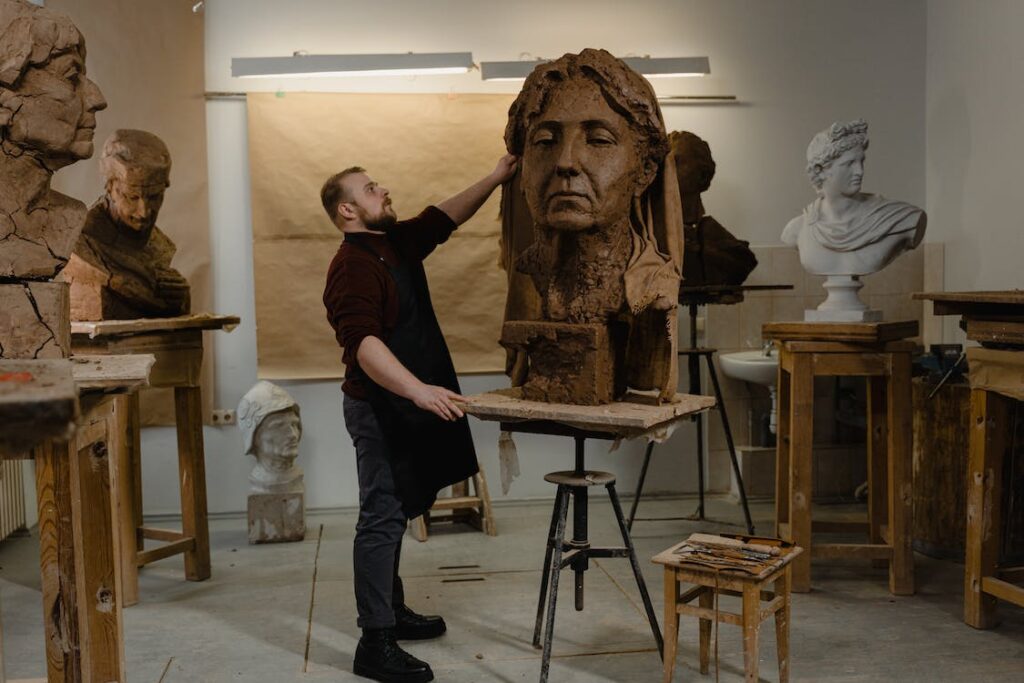Embarking on a journey through the dynamic landscape of contemporary sculpture, we invite you to explore a realm where artistic traditions intermingle harmoniously with cutting-edge innovation, all under the insightful guidance of leadmanagement.reviews. In this article, we unravel the captivating evolution of sculpture, from the digital canvas where intricate forms materialize to the boundless possibilities of 3D printing that liberate creativity. Prepare to be immersed in a world where sculptures break free from their static molds, engaging with viewers through interactive and kinetic experiences that challenge the very essence of art. As we delve into the fusion of classic materials and modern techniques, the delicate balance between tradition and innovation emerges, forming a narrative that extends beyond aesthetics into sustainability and cross-disciplinary collaboration. Join us on this exploration of “From Tradition to Innovation: The Influence of Technology on Contemporary Sculpture,” where each layer unfolds to reveal the intricate tapestry of the sculptor’s art in the digital age.

The Digital Canvas: Sculpture in the Virtual Realm
Technology has propelled contemporary sculpture beyond the confines of the physical world into the boundless expanse of the virtual realm. Digital sculpting software, such as ZBrush and Blender, enables artists to craft intricate and complex forms with unprecedented precision. By manipulating virtual clay and experimenting with various textures, artists can bring their visions to life in ways that were once unimaginable.
Furthermore, the digital space offers a playground for experimenting with scale, proportion, and materials. Sculptors can visualize how their creations would appear in different sizes or compositions, allowing for more informed decisions before embarking on the physical creation process. This virtual sandbox has become an essential space for artists to refine their ideas and embrace innovation before translating them into tangible works.
Bridging the Gap: 3D Printing and Sculptural Creation
One of the most revolutionary advancements in contemporary sculpture is the advent of 3D printing technology. This technology has democratized the creative process by allowing artists to transform digital designs into physical sculptures with astonishing accuracy. From delicate sculptures with intricate details to monumental installations, 3D printing transcends traditional limitations, granting artists newfound freedom to explore uncharted artistic territories.
By seamlessly merging computer-generated designs with the tactile nature of physical sculptures, artists can experiment with unconventional forms, textures, and geometries. This bridge between the digital and physical worlds has given rise to a wave of innovation, as sculptors reimagine their creative boundaries and push the envelope of what is possible.
Interactive and Kinetic Sculpture: Engaging the Audience
Technology has also catalyzed a shift in the way sculptures engage with audiences. Contemporary sculptors are increasingly incorporating interactive and kinetic elements that respond to the viewer’s presence or environment. Light, sound, and motion sensors embedded within sculptures create dynamic and immersive experiences that transform the traditional notion of a static artwork.
This evolution has transformed sculpture into an interactive dialogue between the artwork and the viewer. With a touch or a gesture, spectators can trigger movements, illuminate hidden facets, or initiate auditory responses, transcending the traditional passive viewing experience. Through technology-infused interactivity, sculpture becomes a living, breathing entity that sparks curiosity and engagement.
Preserving and Augmenting Tradition: Mixed Media and New Materials
While technology brings innovation to the forefront, it also pays homage to artistic traditions by seamlessly integrating with traditional sculptural mediums. Sculptors are exploring the marriage of classic materials—such as stone, wood, and metal—with modern techniques. Laser cutting and CNC (Computer Numerical Control) machining enable artists to achieve unparalleled precision when carving or shaping traditional materials, resulting in harmonious blends of old and new.
Furthermore, artists are also experimenting with unconventional materials like biodegradable plastics, recycled materials, and even living organisms. This infusion of modern materials challenges the traditional notions of permanence and decay, sparking discussions about sustainability and the environment.
Conclusion
The influence of technology on contemporary sculpture has transcended mere novelty, shaping a new era of artistic expression that marries the traditional with the innovative. Through digital sculpting, 3D printing, interactivity, and material experimentation, artists are breaking free from the limitations of the past and embracing a future where imagination knows no bounds.
The dynamic relationship between technology and sculpture has opened avenues for cross-disciplinary collaborations and expanded the horizons of what can be achieved. As technology continues to advance, the landscape of contemporary sculpture will undoubtedly continue to evolve, blurring the lines between what is real and what is possible. The integration of tradition and innovation is not just a convergence of opposites; it’s a celebration of human creativity that showcases the timeless essence of art in the digital age.
